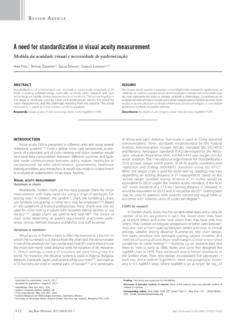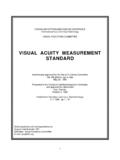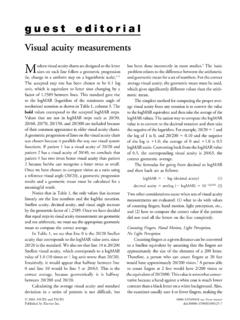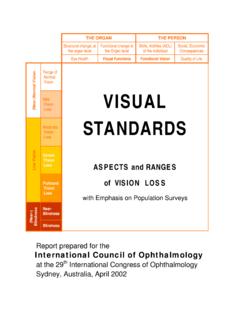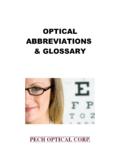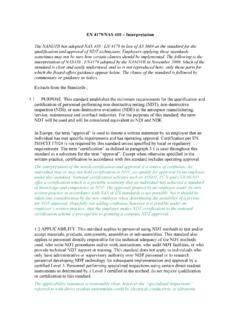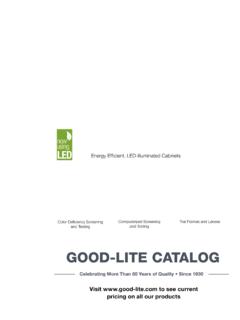Transcription of TABLE 1: GENERAL APPEARANCE ZONES/SURFACE …
1 MANUFACTURING PAINT APPEARANCE STANDARD AS-100-1 Origination Date: 06/11/2004 Revision Date: N/A Page 1 of 6 Originator: Quality Assurance Dept. Revision Number: 0 Paint APPEARANCE Std AS-100-1 1. PURPOSE The purpose of this standard is to describe painted surface APPEARANCE requirements for components. These requirements, with regard to APPEARANCE attributes and surface blemishes, are outlined according to APPEARANCE zones. The purpose of these APPEARANCE requirements is to ensure that the finish of components will meet or exceed customer expectations. 2. SCOPE This procedure applies to Roush Manufacturing and component suppliers and focuses only on the visual/tactile characteristics of the components.
2 This standard applies to primer and top coat surface APPEARANCE , unless otherwise specified. 3. APPEARANCE The components (see TABLE 1) are divided into different APPEARANCE zones to set the APPEARANCE quality requirements of each zone separately. TABLE 1: GENERAL APPEARANCE ZONES/SURFACE CLASS ZONE/ CLASS DESCRIPTION EXAMPLE A Very High Visibility Exterior; Horizontal: Hood, Roof, Deck Lid, Quarter Panels, Fenders, Front & Rear Fascia's Vertical: All surfaces above a horizontal line from the Front to Rear Bumper's Interior: Door inner belt/waist line "A" & "B" Pillars B High Visibility Door openings and inner panels, with the exception of door hinge areas and lower side of door inner panel.
3 All surfaces below a horizontal line from the Front to Rear Bumper's horizontal MANUFACTURING PAINT APPEARANCE STANDARD AS-100-1 Origination Date: 06/11/2004 Revision Date: N/A Page 2 of 6 Originator: Quality Assurance Dept. Revision Number: 0 Paint APPEARANCE Std AS-100-1 TABLE 1: GENERAL APPEARANCE ZONES/SURFACE CLASS ZONE/ CLASS DESCRIPTION EXAMPLE C Moderate Visibility. Underside of parts, recessed areas, or area of part visible when doors, trunk lid, or hood is open. D Low Visibility Any area of a painted surface that is permanently covered by another part. Back side of any part.
4 AUDIT PROCESS Visual inspection, UNLESS OTHERWISE SPECIFIED, shall be performed at an approximate distance of 600mm (approximate arm s length) from the observer, normal to the part surface +/- 90 degrees. Requirements for Appraisers Any person appraising color must be tested for the absence of color blindness and demonstrate color acuity per ASTM-E 1499. Training Training programs should be implemented to educate operators, inspectors, and managers in the techniques and acceptability standards of this specification. Light Intensity In the inspection area, the light intensity shall be 80 to 125 maintained foot-candles.
5 Inspection Area The Inspection Area shall comply with SAE J361. MANUFACTURING PAINT APPEARANCE STANDARD AS-100-1 Origination Date: 06/11/2004 Revision Date: N/A Page 3 of 6 Originator: Quality Assurance Dept. Revision Number: 0 Paint APPEARANCE Std AS-100-1 Lighting Requirements for Color Match Lighting for color match shall comply with SAE J361. Uniformity APPEARANCE must be consistent over entire part. Maximum variation on any individual part for a specific attribute is as follows: DOI - 15 units Gloss - 15 units Orange Peel - One unit of variation within a 120mm span Color - No color variation from the approved color master for Zones A, B or C.
6 Slight variation in Zone D. Use of an X-Rite multi-angle spectrophotometer is the approved measuring method. Target values and tolerances for X-Rite shall be determined by the Product/Platform Team and specified on part print or in a separate program manual. DEVIATIONS If any of the target values, or tolerances in TABLE A cannot be achieved or are deemed inappropriate, it is the responsibility of the Product Team to establish achievable and appropriate target values and tolerances through material and process capability If any of the target sizes, frequencies, or minimum distances of defects in TABLE A cannot be achieved, it is the responsibility of the Product Team to establish achievable and appropriate defect sizes, frequencies, and minimum distances based on material and process capability.
7 Deviations from this standard, if required, must be detailed on the appropriate part drawing. It is the responsibility of the Product/Release Engineer to ensure that any and all deviations are updated. It is the responsibility of any supplier who does not have the recommended measuring equipment to coordinate, through the Product Team, their verification methods with the equipment the Assembly Plant uses. REFERENCES ASTM E284, Standard Terminology of APPEARANCE . ASTM E1499 - Standard Guide to the Selection, Evaluation, and Training of Observers. SAE J361 - Procedure for Visual Evaluation of Interior and Exterior Automotive Trim.
8 RELEASE AND REVISIONS Release. First approved and published June 2004 Revisions. PAINT APPEARANCE STANDARD AS-100-1 Origination Date: 06/11/2004 Revision Date: N/A Page 4 of 6 Originator: Quality Assurance Dept. Revision Number: 0 Paint APPEARANCE Std AS-100-1 TABLE A Maximum Acceptable Size/Count per Part Per Zone, Separated by 100 mm Item Number APPEARANCE Attribute Description Measurement State Condition Zone A Zone B Zone C Zone D 1 Bare Substrate Voids in the paint exposing bare substrate Visual evaluation and comparison to Boundary Sample Finish None None Per Customer Requirements Per Customer Requirements 2 Bleeding Component of lower coating film diffuses into top-coat and discolors Visual evaluation and comparison to Boundary Sample Finish None None Acceptable Acceptable 3 Blushing Whitish or milky areas on coating Visual evaluation and comparison to Boundary Sample Finish None
9 None Acceptable Acceptable Finish None None Up to 3 </= 2mm Dia Acceptable 4 Boiling /pinholes /popping Small bubbles in coating which may have small holes at top Visual evaluation and comparison to Boundary Sample Primer None None None None Finish None None Acceptable Acceptable 5 Bulls-eye Coating surface depressions Visual evaluation and comparison to Boundary Sample Primer None None None None Finish None 1 per surface </= 1mm dia 1 per surface </= 1mm dia, no closer than 200mm Acceptable 6 Chips Removal of coating from underlying coating or substrate in small irregular pieces Visual evaluation and comparison to Boundary Sample Primer No color change None None 1 per surface </= 1mm dia, no closer than 200mm Acceptable 7 Corrosion Rust.
10 Oxidation Visual evaluation and comparison to Boundary Sample Finish Metallic substrates only None None None None 8 Cracked part Cracks/split/punctures in substrate Visual evaluation Finish None None None None 9 Cracking/ crazing of coating Hairline breaks in paint film Visual evaluation Finish None None None Acceptable Finish Primer or substrate not exposed None Max 2 per surface < 2mm dia Max 5 per surface < 2mm dia Acceptable 10 Craters, fish-eyes Small round depressions which may expose underlying substrate Visual evaluation and comparison to Boundary Sample Finish Primer or substrate exposed None None None Max 5 per 100mm < 3mm dia 11 Dings/bumps/ dents Depressions or protrusions in substrate Visual evaluation and comparison to Boundary Sample Finish None None 1 defect per part < 10mm dia Acceptable Finish up to 4 per part </= 1mm separated by 100 mm up to 4 per part </= 1mm separated by 100 mm up to 5 per part </= 1mm Acceptable 12 Dirt Foreign object or contaminant in coating film Visual evaluation and
